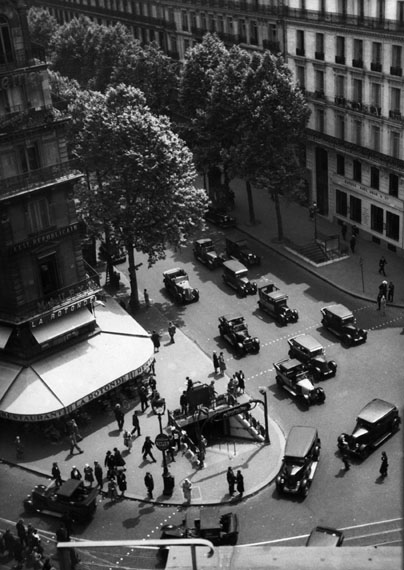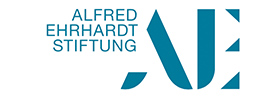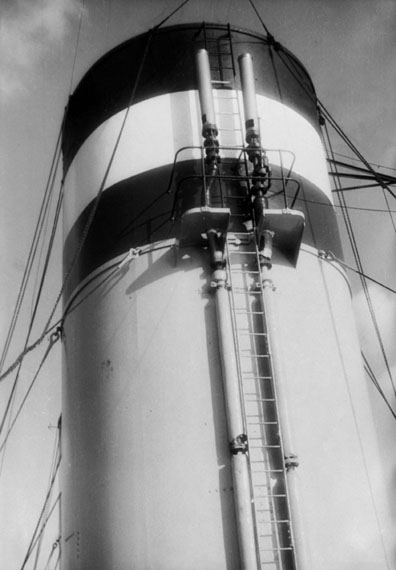
View from Galeries Lafayette Department Store onto Boulevard Haussmann, Paris, 1930
Silbergelatine, 23,4 × 16,6 cm
© Fritz Block Estate Archive, Stockholm/Hamburg
Fritz Block »
PHOTO-EYE FRITZ BLOCK / FOTO-AUGE FRITZ BLOCK
New Photography – Modern Color Slides / Neue Fotografie. Moderne Farbdias
Exhibition: 24 Jun – 10 Sep 2017
Fri 23 Jun 19:00

Alfred Ehrhardt Stiftung
Auguststr. 75
10117 Berlin
+49 (0)30-20095333
info@aestiftung.de
www.aestiftung.de
Tue-Sun 11-18

Pont Transbordeur (Transporter Bridge), Marseille, 1931
Silbergelatine, 23,4 × 17,5 cm
© Fritz Block Estate Archive, Stockholm/Hamburg
"PHOTO-EYE FRITZ BLOCK"
New Photography – Modern Color Slides
Exhibition: 24 June – 10 September, 2017
Opening: Friday, June 23, 2017, 7 pm
Opening remarks: Dr. Roland Jaeger, Exhibition Curator
The German-Jewish photographer Fritz Block (1889–1955) was a highly versatile figure in modern photography. His work spans the period from the so-called "Neue Fotografie" (New Photography) of the late 1920s in Germany to the color photography of the 1940s in the US. Having fallen into a long period of oblivion due to his biography of exile, he is currently being rediscovered. This exhibition presents the first exhaustive retrospective of the work in his estate and includes 130 black-and-white vintage prints, 20 color enlargements from original color slides, and numerous original examples of his works from the illustrated press. This unusually rich trove of materials is being shown in a compact format resembling a filmstrip, which revisits both the presentation of photographs in printed media and in exhibitions typical of the time of Weimar republic.
The life of the photographer was equally multifaceted. He was first active as an architect and proponent of "Neues Bauen," the modern architecture style of the late 1920s. In Hamburg he and his partner ran the architecture firm Dr. Block & Hochfeld. The need to document the construction of his own buildings led him to take up photography in 1929. Using a small-format Leica camera, Block captured the technical structures in the harbor of Hamburg in a style indebted to New Objectivity. He also possessed a sensibility for the expressive depiction of people, photographing individuals ranging from a shipyard worker to a circus clown. His interest in nature is revealed in his photographs of animals and studies of plants, his still lifes and X-ray images of shells. Block also experimented with the unconventional forms of New Vision and arranged his images into photo reportages.
His specialty, however, was the urban and travel photography typical of his era. In Berlin, Block looked at the Radio Tower from unusual perspectives. In Paris, he was fascinated by the structure of the Eiffel Tower and by the vitality of the Boulevard-Cafés and the Les Halles wholesale food market. In Marseille he took advantage of the Transporter Bridge to photograph a view from above, and at the Côte d’Azur he captured the lighthearted leisure activities of the beach. A trip to the US in the fall of 1931 proved particularly productive. In New York, Block photographed the skyline of Manhattan, highrises like the recently completed Empire State Building, the Brooklyn Bridge, the new George Washington Bridge, Broadway at night, people of different ethnicities, and the showmen of Coney Island. In Detroit he produced a striking series of photographs of the Ford factory, its smokestacks, work on the assembly line, and the company’s products.
Although he was not a professional photographer, Block did make use of his photographs by offering them for publication in the illustrated press. In the weekly insert of the Hamburger Anzeiger newspaper he managed to publish multiple photo reportages and title images in the early 1930s. His photographs also appeared in Die Form, a publication of the Deutscher Werkbund (German Association of Craftsmen) and in photographic yearbooks. Block took part in the exhibitions Internationale Ausstellung Das Lichtbild in 1930 in Munich and in the Internationale Foto-Ausstellung in Hamburg in 1932.
However, his photographic career in Germany was limited to a brief timeframe. As a Jew, Block was not allowed to publish his photographs as of 1933 (nor was he allowed to continue his work as a self-employed architect). He decided to take photographs only during his travels abroad. In 1933 he took a zeppelin flight to Brazil; in 1935 he produced a series of images on Petticoat Lane Market in London; and 1938 a cruise around the world enabled him to explore various destinations for exile.
In late 1938 Fritz Block emigrated to the US. Settling in Los Angeles, he made photography his main profession and began working with Kodachrome color photography. In the 1940s he produced and sold (in collaboration with the Museum of Modern Art in New York) novel series of color slides featuring modern architecture in California as well as other images of art, technology, and nature as an innovative medium for contemporary art education in the US—which marks a unique and previously overlooked achievement among exiled photographers.
With its Block exhibition the Alfred Ehrhardt Stiftung makes the photo-eye of an extraordinary photographer visible again.
A twenty-page brochure in German and English is appearing in conjunction with the exhibition (available for a nominal price of 3.00 €).
Accompanying Events:
Sunday, 25 June, 2017, 2pm: tour with the curator
Sunday, 20 August, 2017, 2pm: tour with the curator
�

Ball Game at Juan-les-Pins Beach, Côte d'Azur, 1931
Silbergelatine, 22,6 × 16,4 cm
© Fritz Block Estate Archive, Stockholm/Hamburg
"FOTO-AUGE FRITZ BLOCK"
Neue Fotografie. Moderne Farbdias
Ausstellung: 24. Juni bis 10. September, 2017
Eröffnung: Freitag, 23. Juni, 19 Uhr
Eröffnungsrede: Dr. Roland Jaeger, Kurator der Ausstellung
Der deutsch-jüdische Fotograf Fritz Block (1889–1955) war ein äußerst vielseitiger Exponent der Fotomoderne. Sein Werk reicht von der Neuen Fotografie der späten 1920er Jahre in Deutschland über die Reisefotografie der 1930er Jahre bis zur Farbfotografie der 1940er Jahre in den USA. Aufgrund seines Exils für lange Zeit in Vergessenheit geraten, erfährt dieser Fotograf nun eine Wiederentdeckung. Denn erstmals kann mit dieser Ausstellung aus dem Nachlassarchiv eine repräsentative Retrospektive seines Schaffens gezeigt werden. Sie umfasst 130 Schwarz-Weiss-Abzüge (vintage prints) und 20 Farbvergrößerungen nach originalen Farbdias sowie zahlreiche Druckbelege aus der fotoillustrierten Presse. Für diese ungewöhnliche Materialfülle wurde eine kompakte, filmstreifenartige Präsentationsform gewählt, die zugleich der Anordnung von Fotografien in Printmedien und Ausstellungen zur Zeit der Weimarer Republik nahe kommt.
Die Biografie des Fotografen ist ebenfalls facettenreich: Zunächst trat Block als engagierter Architekt des Neuen Bauens hervor. In Hamburg betrieb er ab 1921 mit einem Partner das Architektenbüro Dr. Block & Hochfeld. Die Dokumentation der Bauausführung eigener Gebäude führte ihn 1929 zur Fotografie. Mit der Kleinbildkamera ›Leica‹ richtete Block sein Foto-Auge im Sinne der Neuen Sachlichkeit auf technische Konstruktionen im Hamburger Hafen. Zugleich besaß er ein Gespür für die ausdrucksstarke Wiedergabe von Menschen, vom Werftarbeiter bis zum Zirkusclown. Naturkundliches Interesse bewies er mit seinen Fotos von Tieren, Studien von Pflanzen sowie Objekt- und Röntgenaufnahmen von Muscheln und Schnecken. Außerdem experimentierte Block mit Ausdrucksformen des Neuen Sehens und arrangierte seine Aufnahmen zu Fotoreportagen.
Seine Spezialität aber war die gleichfalls zeittypische Städte- und Reisefotografie. In Berlin betrachtete Block den Funkturm aus ungewöhnlichen Perspektiven. In Paris faszinierte ihn die Konstruktion des Eiffelturms ebenso wie das Leben in den Boulevard-Cafés oder auf dem Großmarkt Les Halles. In Marseille nutzte er den Pont Transbordeur für einen ›Blick von oben‹ und an der Côte d'Azur hielt er das ungezwungene Strand-vergnügen fest. Eine Rundreise durch die USA im Herbst 1931 fiel besonders ertragreich aus. In New York fotografierte Block die Skyline von Manhattan, Hochhäuser wie das gerade fertiggestellte Empire State Building, die Brooklyn Bridge und die neue George Washington Bridge, den Broadway bei Nacht, aber auch Menschen der verschiedenen Ethnien und die Schausteller von Coney Island. In Detroit entstand eine eindrucksvolle Serie von Aufnahmen der Ford-Fabrik, ihrer Schornsteine, Fließbandarbeit und Produkte.
Obwohl kein Berufsfotograf, wertete Block seine Fotos auch zur Veröffentlichung in der illustrierten Presse aus. In der Wochenbeilage der Tageszeitung Hamburger Anzeiger ist er Anfang der 1930er Jahre mehrfach mit Titelfotos und Fotoreportagen vertreten. Aufnahmen von ihm finden sich auch in Die Form, dem Organ des Deutschen Werkbundes, oder in fotografischen Jahrbüchern. Außerdem beteiligte sich Block 1930 an der Internationalen Ausstellung Das Lichtbild in München und 1932 an der Internationalen Foto-Ausstellung in Hamburg.
Allerdings war seiner fotografischen Karriere in Deutschland nur ein kleines Zeitfenster beschieden. Denn als Jude konnte Block seine Fotos hier ab 1933 nicht mehr publizieren (und auch als Architekt nicht mehr selbständig arbeiten). Er entschied daher, fortan nur noch auf seinen Auslandsreisen zu fotografieren: 1933 unternahm Block einen Zeppelin-Flug nach Brasilien, 1935 schuf er eine Bilderserie vom Petticoat Lane Market in London und 1938 diente ihm eine Kreuzfahrt um die Welt bereits zur Sondierung von möglichen Exilorten.
Ende 1938 emigrierte Fritz Block in die USA, wo er in Los Angeles die Fotografie zu seinem Hauptberuf machte und sich der Kodachrome-Farbfotografie zuwandte. In den 1940er Jahren produzierte und vertrieb er (in Zusammenarbeit mit dem Museum of Modern Art in New York) neuartige Farbdia-Serien mit eigenen Aufnahmen von Bauten und Interieurs der Architekturmoderne in Kalifornien sowie von Formgestaltungen in Kunst, Technik und Natur für einen zeitgemäßen Kunstunterricht in den Vereinigten Staaten – eine singuläre, bisher übersehene Einzelleistung im Bereich der Exilfotografie.
Mit ihrer Block-Ausstellung macht die Alfred Ehrhardt Stiftung das Foto-Auge eines außergewöhnlichen Fotografen wieder sichtbar.
Es erscheint eine 20-seitige Broschüre mit Text in Deutsch und Englisch (Schutzgebühr € 3).
Begleitende Veranstaltungen:
Sonntag, 25. Juni 2017, 14 Uhr: Kuratorenführung
Sonntag, 20. August 2017, 14 Uhr: Kuratorenführung
Der Eintritt ist frei. Um Voranmeldung per E-Mail wird gebeten: info@alfred-ehrhardt-stiftung.de
�

Steamship Smokestack, Hamburg, 1929
Silbergelatine, 17,6 × 12,5
© Fritz Block Estate Archive, Stockholm/Hamburg

View from the Empire State Building Looking onto the Chrysler Building, New York City, 1931
Silbergelatine, 23,4 × 17,5 cm
© Fritz Block Estate Archive, Stockholm/Hamburg

Barker at Coney Island, New York City, 1931
Silbergelatine, 24,0 × 17,6 cm
© Fritz Block Estate Archive, Stockholm/Hamburg